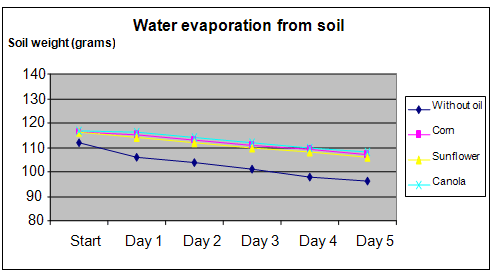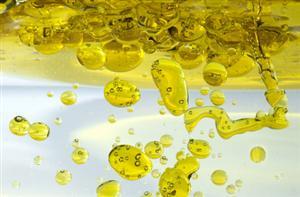| Complexity level: | 6 |
| Project cost ($): | 20 |
| Time required: | 1 hour to prepare, 5 days for the science project experiment |
| Material availability: | Easily found |
| Safety concerns: | Basic safety requirements |
Hypothesis
Applying a layer of vegetable oil to the surface of soil helps in retaining moisture in the soil.
Overview
Evaporation from soil
Evaporation occurs when water changes from its liquid form into vapor. Energy is required for the change to take place because water molecules need to break their bonds in order for the water to turn into a gaseous state. This energy is normally acquired from heat (eg. from the sun on a hot sunny day)or as kinetic energy from the wind. The evaporation process is an important part of the water cycle.
Evapo-transpiration is the combination of water evaporation from the soil and transpiration in plants. These processes lead to significant loss of moisture from the soil. If the rate of evapo-transpiration taking place is higher than the rate of precipitation or rainfall, then the land will become dry and arid.
Water is lost from the soil surface through evaporation. The heat from the sun provides energy required by the water molecules to break their bonds, turn into water vapor and evaporate from the soil surface. As the number of water molecules in the soil reduces, capillary action will help pull more water molecules from further within the soil towards the surface, enabling further evaporation.
Scientific Terms
Materials
The materials required for this science fair project:
- 20 plastic cups
- 3 spray containers
- 1 bottle of corn oil
- 1 bottle of sunflower oil
- 1 bottle of canola oil
- 2000g dry soil
- 500ml tap water
- 1 digital weighing scale
- 1 pail
- 1 black marker pen
Procedure
1. For this science fair project, the independent variable is the type of oil used – corn oil, sunflower oil, canola oil, or none at all. The dependent variable is the amount of water that evaporates from the soil. This is determined by using the digital weighing scale to measure the weight of the cup. The constants (control variables) are the size of the cup, the soil-to-water mix ratio, the room temperature and the amount of oil used.
2. The 20 cups are separated into 4 groups of five cups each. The groups are accordingly labeled corn oil, sunflower oil, canola oil and no oil.
3. 2000 grams of dry soil is mixed with 500ml of tap water in a pail. Using the digital weighing scale, 100grams of mixed soil is placed in each of the 20 cups.
4. Corn oil, sunflower oil and canola oil are poured into the spray containers. 5ml of oil is sprayed onto the soil in the cups marked as corn oil, sunflower oil and canola oil, according to the labels on the cup.
5. The weight of the cups together with the soil is measured. The total weight for the 5 cups in each group is then divided by 5 to obtain the average weight and it is recorded in the table given below.
6. The 20 cups are kept in a place where the temperature and humidity are constant. The moisture from the cups is allowed to evaporate. Everyday, for the next 5 days, the weight of the 20 cups is measured. The total weight for each group is divided by 5 and the average weight is recorded in the table given below (rounded to the nearest gram).

Results
It was observed that the amount of water that evaporated from the soil sprayed with the vegetable oils was less than the amount of water that evaporated from the soil without any oil added. There was no significant difference in the amount of water lost from the cups containing different types of vegetable oil.
|
Amount of water evaporation (grams) |
||||||
|
Start |
Day 1 |
Day 2 |
Day 3 |
Day 4 |
Day 5 |
|
|
Without oil |
112 |
106 |
104 |
101 |
98 |
96 |
|
Corn oil |
116 |
115 |
113 |
111 |
109 |
107 |
|
Sunflower oil |
116 |
114 |
112 |
110 |
108 |
106 |
|
Canola oil |
117 |
116 |
114 |
112 |
110 |
108 |
The graph below represents the results of our science project experiment.

Conclusion
Our hypothesis, that applying a layer of vegetable oil to the surface of soil helps in retaining moisture in the soil, has been proven correct.
In dry areas where the amount of rainfall is small, it is very important to retain moisture in the soil. If the soil is left exposed and moisture is allowed to escape through evaporation, the land will become arid, subjected to soil erosion and eventually become unsuitable for vegetation growth. Having a layer of grass or planting more trees to provide shelter, will help to retain the moisture within the soil.
Also consider
Repeat this science fair project using different types of soil like sand or clay.
The science project experiment can also be modified to evaluate the impact of different conditions such as temperature and humidity, on the rate of moisture loss.
References
Evapotranspiration - http://en.wikipedia.org/wiki/Evapotranspiration
Summary of the water cycle - http://ga.water.usgs.gov/edu/watercyclesummary.html

